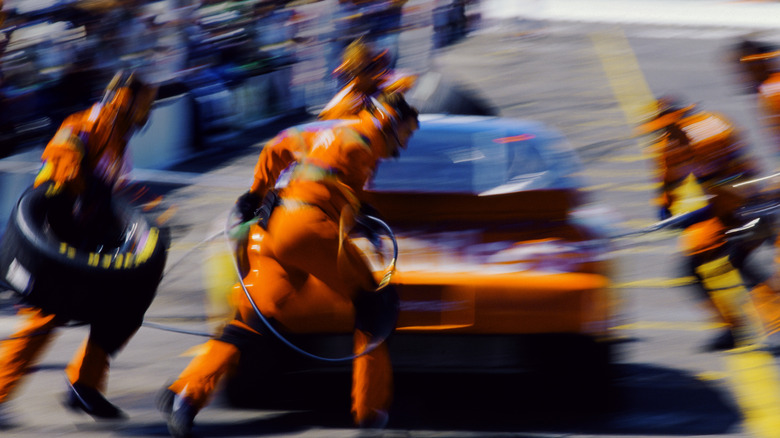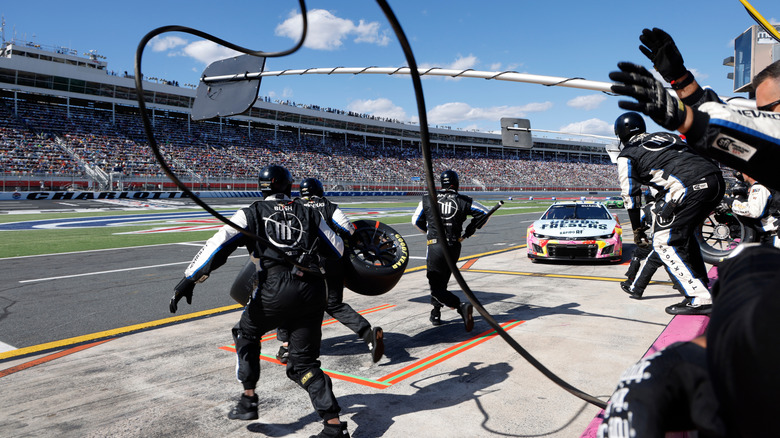The Secret Behind The 10-Second Tire Change In NASCAR Pit Stops
NASCAR pit stops are more of a carefully-choreographed ensemble performance than anything, requiring precision, timing, and teamwork to get the car back onto the road as quickly as possible. Every one of a pit crew's members has a specific, specialized task, ranging from fueling the car to wiping down the windshield and everything in between. Of course, one of the most famous and noticeable jobs of them all is the tire changer.
When the average person changes their own spare tire on the side of the road, it usually takes around five or ten minutes. You have to jack the car up, undo all the bolts, take off the tire, seat the new one on – and they're heavy, too. And then you bolt it all back in place. How on Earth do you cut that down to ten seconds or less?
The answer lies in two key areas: training and equipment. You're not changing anything that fast with a tire iron, after all. Moreover, it doesn't matter how good a pneumatic gun you have if you don't have the technique and coordination to use it, bearing in mind that you have to manhandle a tire out of the way on top of all that. It sounds like a simple job on the face of it; all you're doing is changing a tire. But the more you think about it, the more it resembles a sport unto itself. Let's dive in and talk about how tire changes in NASCAR work and what tools they use.
The art of changing a tire fast
Changing a car tire, in principle, is a basic enough concept. Doing it in seconds is another story entirely; let's take a closer look at the process in action.
When a car comes into the pits, you have a team of five responsible for tires: a jackman, two tire carriers, and two tire changers. Each of these people is responsible for either the front or the rear of the car. The jackman is up first, throwing the jack underneath the far side of the car (the side facing away from the pit wall) and giving the tire changers access, a process which takes roughly half a second after first contacting the car. The wheels themselves feature a single center-lock nut, much like the cars in other racing disciplines, so there's no need to reposition to undo five separate bolts. The tire changer removes the tire, with the carrier replacing it on the hub; it's now about 2.5 seconds in. The tire changer then tightens the new tire, completing a single change in about three seconds total. This process repeats itself on the other side, again beginning with the jackman lifting that end of the car. After all that, the car gets sent off, and the crew hauls the old tires away.
This symphony occurs practically while the vehicle is still moving, with tire changers having to leap over the wall in front of a car slamming on its brakes from 60 mph to a dead stop in a box the size of a parking space. Absolute precision means the tire carriers don't have to run as far with heavy tires, and drivers won't box each other in, both of which cost time.
Using the right tools for the job
The primary weapon of the tire changer is their pneumatic gun. These tools barely resemble what you would normally see at many auto shops, much less what's packed in a car's toolkit, and can loosen or tighten a tire bolt in fractions of a second. The old style of tires used a more traditional five-lug setup, but times have changed. Many innovations have come about in recent years, such as NASCAR transmissions, let alone the tools used to service everything.
Much like commercial air wrenches, NASCAR units use compressed air to drive the wheel nut off. The specific model we're concerned with is the Supersport Nextgen, an air wrench that, unlike Formula One, uses a manual shuttle to change whether it's loosening or tightening. These guns are shared between the NASCAR Cup series, GT racing, and endurance racing. They spin with an incredible 2,590 lb/ft torque and rotate at up to 11,500 RPM.
The wheel nut itself is the other element to this equation. Unlike in the old days, where no fewer than ten nuts per tire were in play at any given change, there is only a single nut being manipulated here. The gun's head houses a specialized device that captures and holds onto the nut between changes, meaning there's no need to seat the gun over a new nut, further cutting down time. Ultimately, that's what it's all about. In a series famed for having incredibly close pack racing, cutting down fractions of a second can mean the difference between tens of positions.


